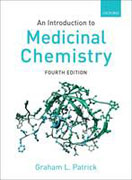
The average person in the UK will take more than 14,000 pills over the courseof their life, yet few people consider the long road of development that has made that drug work without being toxic. An Introduction to Medicinal Chemistry presents the field in an engaging style that is very accessible to students.Medicinal chemistry is a fast-moving field whose continuous new developments have far-reaching implications for world health. As such, this text presents acomplete course in medicinal chemistry, from first principles of drug action,to design and development, to specific drugs from HIV inhibitors to painkillers. The book builds on the history of drug development, but does not assume much background knowledge. The focus is on building upon the understandings of the molecular function of drugs, and from there, taking a broad overview of thetopical issues and most frequently used techniques. An Introduction to Medicinal Chemistry remains a leading text for the growing number of medicinal chemistry courses internationally, especially as modules in medical chemistry become a more popular option on chemistry courses. INDICE: Drugs and drug targets: an overview; PART A: DRUG TARGETS: STRUCTURE AND FUNCTION; 2. Protein structure and function; 3. Enzymes: structure and function; 4. Receptors: structure and function; 5. Receptors and signal transduction; 6. Nucleic acids: structure and function; PART B: PHARMACODYNAMICS ANDPHARMACOKINETICS; 7. Enzymes as drug targets; 8. Receptors as drug targets; 9. Nucleic acids as drug targets; 10. Other drug targets; 11. Pharmacokinetics and related topics; CASE STUDY 1: STATINS; PART C: DRUG DISCOVERY, DESIGN, ANDDEVELOPMENT; 12. Drug discovery: finding a lead; 13. Drug design: optimizing target interactions; 14. Drug design: optimizing access to the target; 15. Getting the drug to market; CASE STUDY 2: THE DESIGN OF ACE INHIBITORS; CASE STUDY 3: ARTEMISININ AND RELATED ANTIMALARIAL DRUGS; CASE STUDY 4: THE DESIGN OF OXAMNIQUINE; PART D: TOOLS OF THE TRADE; 16. Combinatorial synthesis; 17. Computers in medicinal chemistry; 18. Quantitative structure-activity relationships(QSAR); CASE STUDY 5: DE NOVO DESIGN OF A THYMIDYLATE SYNTHASE INHIBITOR; CASE STUDY 6: DESIGN OF A SEROTONIN ANTAGONIST AS A POSSIBLE ANXIOLYTIC AGENT; PART E: SELECTED TOPICS IN MEDICINAL CHEMISTRY; 19. Antibacterial agents; 20. Antiviral agents; 21. Anticancer agents; 22. Cholinergics, anticholinergics, andanticholinesterases; 23. Drugs acting on the adrenergic nervous system; 24. The opium analgesics; 25. Anti-ulcer agents; CASE STUDY 7: DESIGN OF A NOVEL ANTIDEPRESSANT.
- ISBN: 978-0-19-923447-9
- Editorial: Oxford University
- Encuadernacion: Rústica
- Páginas: 816
- Fecha Publicación: 22/01/2009
- Nº Volúmenes: 1
- Idioma: Inglés
